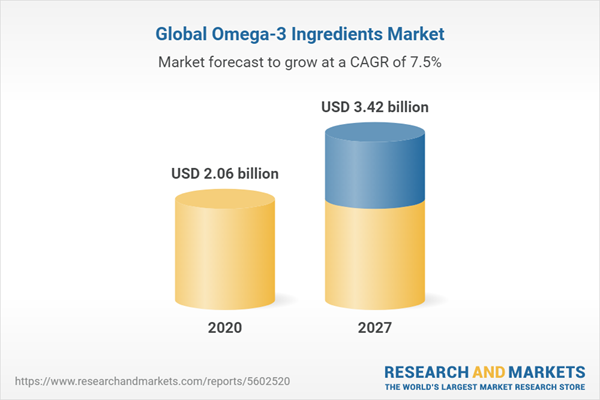Market Trends
The growing popularity of certified food ingredients coupled with a concern for health and wellness to maintain proper health is creating more demand for omega-3 ingredients. Increasing investments in research and development activities by food and beverage manufacturers and rising advancements in technology are boosting the omega-3 ingredient market’s growth. Furthermore, EPA and DHA have been gaining popularity in the market and are becoming - part of the consumer’s daily diet.
Growth Factor
The rising prevalence of certain diseases has increased the demand for omega-3-ingredient products.
A rise in the geriatric population and a high prevalence of cardiovascular diseases is expected to propel market growth. According to the World Health Organization, cardiovascular diseases (CVDs) are the leading cause of death globally, claiming an estimated 17.9 million lives each year. More than four out of five CVD deaths are due to heart attacks and strokes, while one-third of these deaths occur prematurely in people under 70 years of age. These alarming statistics have drawn people’s attention to their health and dietary habits. Consumers are spending more on their dietary supplements and including omega-3 ingredients in their diets to develop strong immunity and support heart and brain health, which is expected to boost the demand for omega-3 ingredient products in the coming years. Furthermore, rising cases of obesity and diabetes are expected to increase the demand for DHA. An unhealthy diet, physical inactivity, tobacco use, and harmful alcohol use are all risk factors for heart disease and stroke. These risk factors are showing a growing trend in the current population. Obesity and diabetes are other agitating reasons for heart disease. Diabetes affected approximately 463 million adults aged 20-79 in 2019 (Source: International Diabetes Federation). This has led to the growth of the omega-3 ingredient market. BASF nutrition and health has partnered with Ideogen for the introduction of the omega-3 fatty acid solution ‘hepacor’ to Europe. This food contains a concentrated amount of EPA and DHA that will help to treat fatty liver disease. lant-based Multi Omega 3-6-9 gummies and soft gels from Forest Remedies. The Impact of COVID-19 on the Omega-3 Ingredients Market
The market for omega-3 ingredients is expected to grow positively because of the COVID-19 outbreak. As the number of people infected with the COVID-19 virus grows, the demand for healthy food products has increased worldwide. The consumption of a nutrition-rich diet has increased during the pandemic to keep overall health on track, which has increased the demand for omega-3 ingredients in the market.
Competitive Insights
The rising prevalence of various diseases across the globe has led to the entry of several new players in the omega-3 ingredient market. To increase their clientele as well as increase their market share in the upcoming years, many of these market players have taken various strategic actions like partnerships and the development of novel solutions, which are expected to keep the market competitive and constantly evolving. Major market players like BASF SE and DSM, among others, have been covered along with their relative competitive strategies. The report also mentions recent deals and investments by different market players over the last few years. The company profiles section details the business overview, financial performance (public companies) for the past few years, key products and services being offered, along with the recent deals and investments of these important players in the omega-3 ingredients market.
Market Segmentation:
By Type
- Eicosapentaenoic acid (EPA)
- Docosahexaenoic acid (DHA)
- Alpha-linolenic acid (ALA)
By Source
- Marine oils
- Plant oils
By Application
- Pharmaceuticals
- Pet and Animal Feed
- Supplements and Functional foods
- Infant Formulas
- others
By Geography
- North America
- USA
- Canada
- Mexico
- South America
- Brazil
- Argentina
- Others
- Europe
- Germany
- France
- United Kingdom
- Spain
- Others
- Middle East and Africa
- Israel
- Saudi Arabia
- Others
- Asia Pacific
- China
- Japan
- South Korea
- India
- Thailand
- Indonesia
- Others
Table of Contents
Companies Mentioned
- Reckitt Benckiser Group plc
- Unilever Life
- Abbott Laboratories
- Amway Corp
- Sanofi S.A.
- GlaxoSmithKline plc
- The Nature's Bounty Co.
- Omega Natural Science, Inc.
- Bionova
- Arkopharma
- Blackmores
- KD Pharma Group
Table Information
| Report Attribute | Details |
|---|---|
| No. of Pages | 124 |
| Published | April 2022 |
| Forecast Period | 2020 - 2027 |
| Estimated Market Value ( USD | $ 2.06 billion |
| Forecasted Market Value ( USD | $ 3.42 billion |
| Compound Annual Growth Rate | 7.5% |
| Regions Covered | Global |
| No. of Companies Mentioned | 12 |









